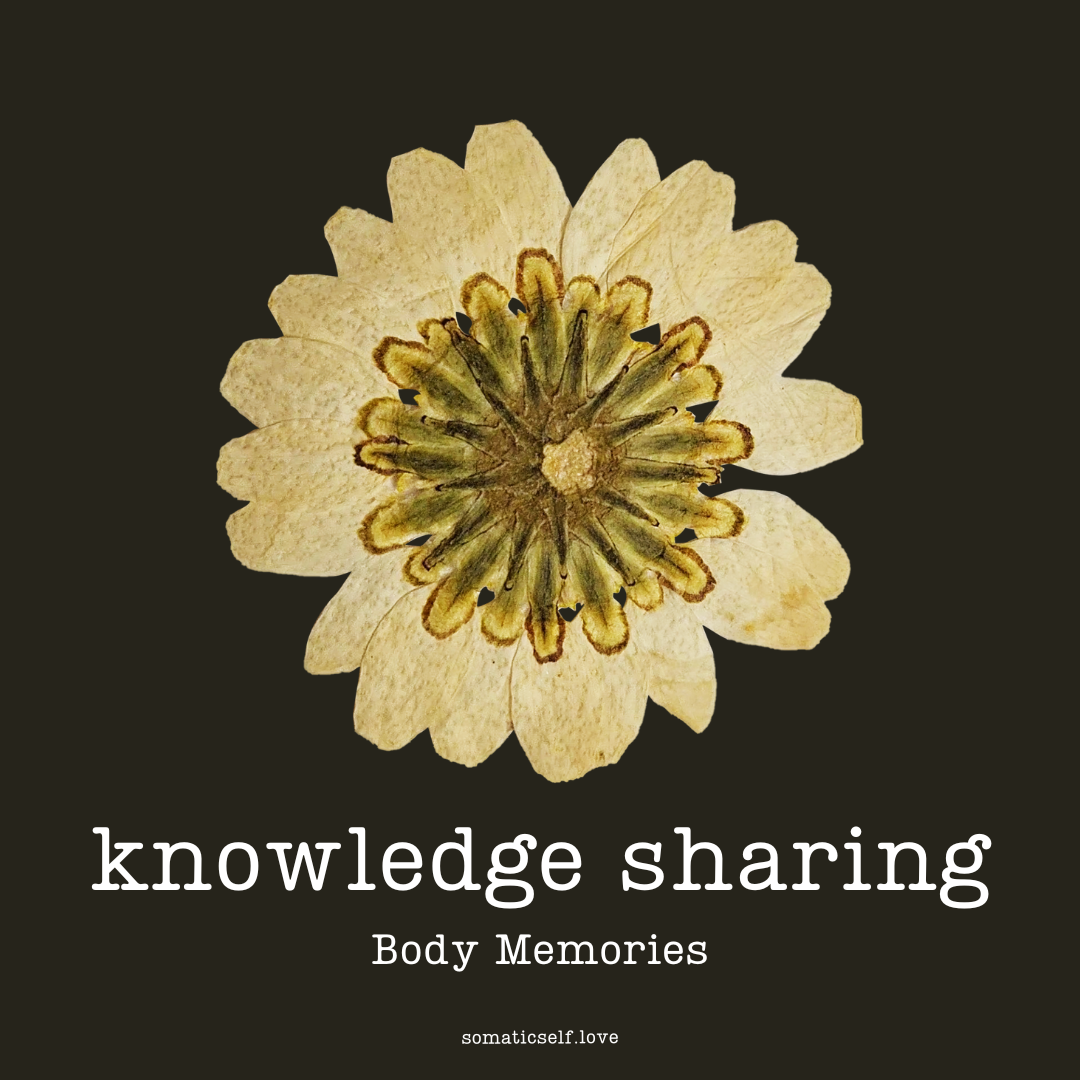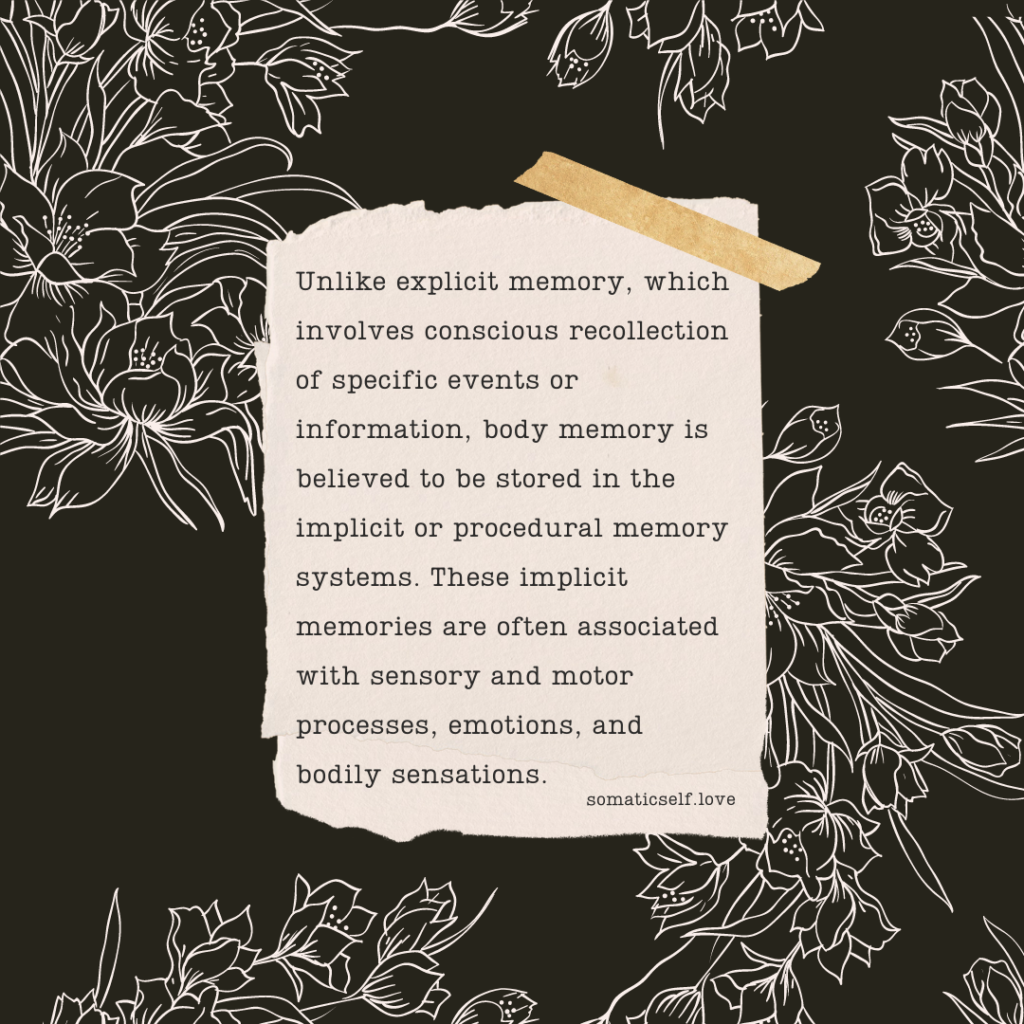Body Memory

Body memory refers to the phenomenon where the body retains or “remembers” past experiences or traumas at a physiological level, even if the individual cannot consciously recall those experiences. It suggests that our bodies have the capacity to store and encode memories beyond the realm of explicit or conscious memory.
Unlike explicit memory, which involves conscious recollection of specific events or information, body memory is believed to be stored in the implicit or procedural memory systems. These implicit memories are often associated with sensory and motor processes, emotions, and bodily sensations.
Body memory can manifest in various ways. For example, individuals who have experienced trauma may exhibit physical responses, sensations, or reactions that seem disconnected from their present circumstances. These responses can include muscle tension, pain, physical discomfort, trembling, changes in breathing patterns, or heightened arousal in response to triggers that remind the body of the traumatic event.

Body memory is commonly associated with traumatic experiences, especially those involving physical or sexual abuse, accidents, or violent events. It is believed that the body’s cellular and neurophysiological systems retain the imprints of these experiences, even when conscious memory may be fragmented or entirely absent.
Therapeutic approaches that focus on working with body memory aim to address the effects of past trauma and promote healing. These approaches often involve somatic techniques such as body-centered therapies, somatic experiencing, sensorimotor psychotherapy, Qi Gong and breathwork.
By engaging with the body’s memory and releasing stored tension or trauma, individuals can often experience a reduction in physical symptoms, emotional distress, and an overall sense of healing and integration.
It’s important to note that the concept of body memory remains an area of ongoing scientific research and debate. While many anecdotal reports and clinical observations support its existence, further research is needed to fully understand the mechanisms and implications of body memory.
Additional Research
Research on body memories, lineage trauma (also known as intergenerational or transgenerational trauma), and trapped energy in our bodies is relatively recent and still growing; however, these concepts have gained attention and support from various studies and academic literature. Here are some studies and resources that explore these topics:
- Body memories and somatic experiencing:
- Rothschild, B. (2000). The body remembers: The psychophysiology of trauma and trauma treatment. New York: W.W. Norton & Company.
- This book provides an in-depth understanding of the psychophysiology of trauma and how the body stores traumatic memories. It also explains the principles of somatic experiencing, a body-centered therapy for resolving trauma.
- Intergenerational trauma:
- Yehuda, R., Daskalakis, N. P., Bierer, L. M., Bader, H. N., Klengel, T., Holsboer, F., & Binder, E. B. (2016). Holocaust exposure induced intergenerational effects on FKBP5 methylation. Biological Psychiatry, 80(5), 372-380.
- This study demonstrates the transmission of trauma-related epigenetic changes from Holocaust survivors to their offspring, providing evidence for the concept of intergenerational trauma.
- Kellermann, N. P. F. (2001). Transmission of Holocaust trauma – An integrative view. Psychiatry: Interpersonal and Biological Processes, 64(3), 256-267.
- This article reviews various studies on the transmission of Holocaust trauma and proposes an integrative model to explain the intergenerational effects of trauma.
- Trapped energy and somatic therapies:
- Levine, P. A. (2010). In an unspoken voice: How the body releases trauma and restores goodness. Berkeley, CA: North Atlantic Books.
- In this book, Peter Levine, the founder of Somatic Experiencing, explains how trauma affects the body and nervous system, and how his approach helps release trapped energy and restore balance.
- Van der Kolk, B. A. (2014). The body keeps the score: Brain, mind, and body in the healing of trauma. New York: Viking.
- This widely recognized book by Bessel van der Kolk, a leading trauma researcher, presents an overview of the latest research on trauma and the effectiveness of various somatic therapies for releasing trapped energy and healing trauma.
These resources provide insights into the concepts of body memories, lineage trauma, and trapped energy in our bodies. It’s important to note that research in these areas is ongoing, and our understanding of these phenomena will continue to evolve as more studies are conducted.